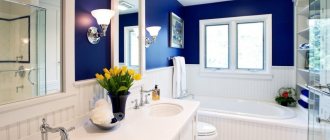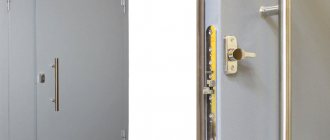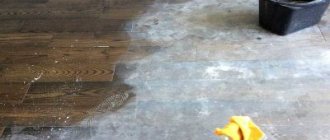Apartment renovation is worse than a nuclear war. This expression occurs in the conversations of people who have started a major renovation of their apartment, deciding to change the wallpaper, update the ceilings, fix the plumbing and other things. Indeed, even at the final stage of the renovation, when everything has already been pasted over/painted/whitewashed, there are still a lot of little things that will require you to spend both time and effort. This type of work also includes cleaning the house. How to clean floors after renovation from white deposits? This question is asked by those who have decided to resort to one of the old but reliable methods of finishing the ceiling - whitewashing.
How to clean floors after renovation from white deposits
Cleaning the floor after renovation
How to make cleaning easier after renovation?
Cleaning up after renovation is not an easy task. Fine and nasty dust generated as a result of construction work will have to be raked out from everywhere in large quantities. It gets clogged up in upholstered furniture, settles on cabinets, and sometimes gets clogged up in the most inaccessible places.
Important! Fine construction dust has a negative impact on human health. It settles in the respiratory system and often causes the development of respiratory diseases. Coughing and pain in the lungs are common companions for those who do repairs and do not follow safety precautions, that is, do not use personal protective equipment.
Damage from construction dust
Minimizing harm from construction dust
That is why it is important to remove as much debris and dust as possible after completing the repair. And also, before starting this large-scale operation, it is recommended to make some preparations that will protect the interior from dust and whitewash.
It is advisable not to leave anything in the room where the work will be carried out - all the furniture is taken out, it is best to pack things in boxes or bags so that dust does not penetrate to them even through small cracks. It is recommended to wrap the furniture itself with plastic film, because even if it is standing in another room, it will be “attacked” by the smallest particles of building mixtures. It is recommended to wrap anything that cannot be taken out with cling film, as it will not allow dust to get to the interior item.
Preparing furniture for repair
If a procedure such as whitewashing a ceiling is being carried out, and there is already a new floor covering on the floor or it is not being replaced at all, since it will be used further, then the floors need to be protected as much as possible. To do this, the base is covered with a thick film, which is then fixed along the baseboards using masking tape.
Important! If you neglect fixation, the film will become crumpled and will be of no use. It is also important to seal all joints of individual panels with tape.
Some people use regular old newspapers instead of film, but this method is not the most reliable. When wet, paper loses its strength and tears easily. To maximize the safety of the base, it is recommended to lay newspapers in at least two layers. It is not recommended to use a cloth to cover the surface, as it will still allow all the fine dust to pass through.
In this case, polyethylene film is used to protect furniture
It is worth remembering that it is easier to prevent contamination, and especially whitewash, than to later wash off all the consequences of your negligence. Sometimes some coatings become hopelessly damaged when exposed to white dust.
Additional Tips
- To save energy when cleaning after repairs, try to protect all surfaces as much as possible from dirt, dust or paint. To do this, try to remove as much furniture from the room as possible, and wrap the remaining furniture in plastic or stretch film. Also try to completely cover the floor with thick film, securing it with masking tape on the baseboards.
- For easy cleaning of glass on windows, they can also be covered with a stretch film that simply sticks to the glass. You can also apply a concentrated solution of toothpaste or toilet soap to the glass, which will help you easily clean the glass later.
Repairs should not be rushed. It is better to spend extra time on precautions before starting “dirty” work, removing everything possible from furniture and interior items, and securely covering the rest, than to then suffer through restoring dirty things, windows, walls and spending a lot of extra effort on cleaning. Well, if it happens that you have to wash the floor of whitewash, paint, plaster, we hope that our advice will be useful to you and will help restore cleanliness and order in the house quickly and effectively.
Share on social media networks:
Features of whitewashing as a finishing material
Whitewashing is one of the cheapest and most affordable options for finishing the ceiling, and it is also time-tested. Despite the fact that now this technology has been partially replaced by more modern design methods, it is still in demand, and all thanks to its special advantages:
- accessibility and low cost of the method;
- the ability to do the work with your own hands without the involvement of craftsmen;
- environmental friendliness and purity of the materials used;
- strength, reliability, stability of the applied decorative layer;
- a classic design option for a regular white ceiling.
Whitewashing can be done either with chalk or lime - these materials are available and always on sale, and are inexpensive.
Chalk mortar for whitewashing ceilings
Advice! If the ceiling has previously been whitewashed, it is recommended to use the same material that was used previously to update the layer. That is, if the upper part of the room was covered with lime, then it is important to use a lime composition.
Whitewash is precisely the material that most often leaves a white coating on the floor surface after repairs. It is sometimes very difficult to wash off, especially if it ends up in the wrong place, for example, on the floor. And during repairs, it is unlikely that it will be possible to completely avoid contamination of the base, even if you cover the entire room with film. The fact is that the protective coating can be easily damaged and all the dirt will fall onto the floor through the resulting hole. It is unlikely that anyone will pay attention to a small hole in polyethylene and immediately repair it during the work process. That is why, when deciding to whitewash the ceiling, it is worth finding out how the process of washing the floors takes place.
Ceiling whitewashing process
Stripping solutions
In order to avoid the formation of dust when removing the layer covering the walls, special solutions are used. You can make them yourself or buy them in a store. As a result of their reaction with whitewash substances, the layer that needs to be removed softens and comes off without effort.
Homemade
Homemade solutions are not only very easy to prepare, but it also saves money, since all the necessary components are not expensive and are always on hand.
To wash off lime
If the walls were treated with lime, you will need the following preparations:
Procedure:
To remove chalk
In situations where the walls were whitewashed with chalk, the following components will be needed for the solution:
Procedure:
Purchased
In addition to self-prepared washes, you can use purchased professional formulations. You can purchase them in construction stores or order them online, even with delivery.
Examples of effective washes:
The average price is from 600 rubles. for a volume of 5 liters.
If the thickness of the whitewash layer is large, then before applying special agents, the walls must be treated by cleaning, for example, by grinding with a machine or with a spatula.
Washing floors after renovation: general recommendations
In general, cleaning the floor after finishing renovation work is not much different from regular cleaning. But it is often necessary to use special solutions or components to deal with white spots on the base. Before we talk about floor cleaning products, we will share a few useful tips for cleaning the base:
- You cannot use soda to wash linoleum - its effect will have a bad effect on the appearance of the coating;
- It is best to remove paint and other similar liquids from the coating immediately - then it will be more difficult to wash them. The same applies to whitewash stains;
- laminate and other similar coatings should not be rubbed with abrasive materials - the top protective layer can be damaged;
White plaque on laminate
- You cannot treat varnished surfaces with potassium permanganate - stains will appear on the floor;
- It is best to wash all stains after the initial treatment of the floor - sweeping and wet cleaning;
- It is better to wash the floors from the wall farthest from the door , moving towards the exit, so as not to trample on the just washed surface;
- It is recommended to change the water as often as possible when washing floors after repairs - this way you can quickly deal with corrosive stains and avoid stains, which especially often appear during whitewashing.
Try to change the water as often as possible
We use laundry soap
Laundry soap is a universal stain remover. The second wash is carried out with this product. It will not remove white stains, but it will significantly reduce dirt. Fresh whitewash in a small amount will be completely removed by laundry soap. It is also indispensable for removing lime and chalk from doors and window frames.
Soapy water is prepared as follows:
- A small part of the bar is ground on a grater.
- The shavings are placed in a container with warm water.
- Shake until dissolved.
The product is used to wash the floor, doors, windows, and if the finishing allows, then the walls. To increase efficiency, add a little vinegar.
Advice: If you wet the surfaces with a concentrated soap solution before working with whitewash, it will be much easier to remove lime.
How to clean the floor after whitewashing?
To remove white deposits from the floor, you will have to be patient and purchase several products that make the job easier. You will also need plain water, a couple of rags, and a mop.
Advice! It is recommended to carry out all dirty work wearing protective gloves. This is especially true if the work is carried out using chemicals. If you neglect to use gloves, you can easily burn the skin of your hands.
How to clean the floor from white deposits after renovation
Methods for removing white deposits and stains from the floor differ depending on the type of floor covering. Let's take a closer look at each option.
Method 8
If you don't know how to clean grout from tile floors, experiment with the following methods and products, keeping in mind that smooth glazed tiles can be cleaned well with a dry cloth, followed by water and detergent. Matte glazed – with an acid-containing substance.
- A mixture of oxalic acid and water washes the grout;
- Table vinegar, can be diluted with water;
- Acid-containing substances will help, for example, “Deterdek”, “Litoclean”;
- Cleaning product "Cinderella";
- You should try gasoline, acetone, and white spirit.
We suggest you familiarize yourself with How to clean an iron from burnt fabric: how to remove carbon deposits at home
How to clean parquet after renovation?
Parquet is a reliable coating, but it is very delicate. It does not like to come into contact with water - due to its exposure, the coating loses its beautiful and noble appearance and may swell. That is why it is not recommended to wet it abundantly. Let's look at the easiest way to remove whitewash and white deposits from parquet.
Using a parquet cleaner
Table. Means for combating whitewash on parquet.
| Means | a brief description of |
| Dish detergent | After dissolving a little of this product in water, the parquet is carefully treated with a rag soaked in the solution. The composition easily copes with water-soluble types of stains - putty, construction dirt, including whitewash. |
| Vegetable oil and vinegar | Before using these products, it is recommended to wipe the parquet with a clean damp cloth. After this oil is dissolved in cool water in a ratio of 1:100. The parquet is washed with the resulting composition - the whitewash will be removed very easily. After this, the floors are wiped with a weak vinegar solution. |
| Kerosene | Suitable for severe dirt. Dissolves in a bucket of water (5 l) in an amount of 100-150 g. The resulting solution is used to treat contaminated floors. The method removes stains well. It is important to ventilate the room well after finishing work, and wipe the floors with a weak vinegar solution - it will help cope with the smell of kerosene. |
Important! Parquet does not like the effects of aggressive chemicals, so you can only work on it with soft compounds. This can be methyl alcohol, white spirit, kerosene. But still, before using them, it is better to check on an inconspicuous area of the parquet how the material will react to contact with the chosen product.
Parquet should not be rubbed with coarse abrasive materials. Neither metal brushes nor rough scrapers are suitable for processing it. They will simply ruin the coating by scratching the protective top layer.
What products help best remove dirt?
To get the best results, you will need to add some manganese or acetic acid to the water. If you use potassium permanganate, then be very careful and try those places where the floor is dirty. If your floor covering is already old, then the best and most reliable option for it is to use milk and water, and they must be used in the same proportion.
When there is a lot of whitewash left on the floor covering, then you need to try to change the water in the bucket as often as possible, and do this as soon as it acquires a slightly whitish tint, this way you can wash the floor faster. If you have tiles on your floor that have become dirty from paint, lime or whitewash, then the most common acetic acid will help you get rid of these stains.
To get rid of paint, try using baking soda, which contains trisodium phosphate, or a product called Mole. This product will help you get rid of not only dirt on the tiles, but also rust, after which the tiles will look beautiful and look like new.
We invite you to familiarize yourself with Freshwater fish: where they live, what they eat, how they reproduce
If you are washing a regular floor after completing repair work, then again it is better to use ordinary acetic acid, it helps get rid of whitewash perfectly, or you can use a small amount of sunflower oil. However, be careful not to overdo it with the latter, otherwise your floors will be greasy and it will not be very easy to get rid of it. Even now they have begun to use special detergents, such as Fairy.
Just during the renovation, try not to neglect your floors too much and wipe them as often as possible, especially if the work was very dirty. After all, it is much easier to immediately wash off small stains on the floor covering than to think later about how to save it from heavy deposits and dirt. For example, the whitewash must be washed off on the same day, or better yet, right away, before it is completely ingrained into the floor covering, then you may not be able to wash it at all, and it will remain damaged or you will have to re-floor the floors. Simply soak a sponge in soapy water and wash away the dirt from the floor.
How to remove whitewash from laminate flooring?
Laminate is a coating that, like parquet, really does not like water. Excessive moisture will negatively affect this type of coating, so you cannot use large quantities of water for washing. Although in general, this type of finishing material for finishing the floor is quite durable and reliable. But you still need to clean it carefully, otherwise you can damage the outer protective layer. And without it, the material will become susceptible to all types of mechanical and physical stress, as a result of which its service life will be dramatically reduced.
Cleaning laminate flooring should be done with great care
A vinegar solution of 1 - tbsp will help with whitewash stains on laminate flooring. l. dissolves in a 5 liter bucket of water. After this, a soft cloth (preferably microfiber) is moistened with the resulting solution and wrung out thoroughly - no liquid should flow from it. The floors are then treated with a damp cloth. The final stage is washing the laminate with plain water.
Important! The rag should be rinsed in a vinegar solution as often as possible. The cleaner it is, the easier it will be to remove dirt.
Just like parquet, laminate can be treated with vegetable oil. It is diluted in warm water in a ratio of 1:100. After treating the laminate with this composition, it is wiped with vinegar diluted in water (2 tablespoons per 5-liter bucket).
On a note! Vinegar can be replaced with citric acid.
Washing vacuum cleaner for laminate flooring
Another remedy for removing white plaque from laminate flooring is a solution of ordinary table salt. The main thing is not to dilute it in water in large quantities, otherwise stains may remain on the floor. The optimal consumption is 0.5 cups of salt per bucket of water. After treating with this composition, the floor is wiped with a clean hoe moistened with plain water.
Vinegar
This acid has long been “grandmother’s” favorite means for cleaning floors after whitewashing. It is easy to use and no less effective than any expensive factory solution. The only thing that vinegar lacks in flavor is its aroma, but that is also easy to neutralize.
We invite you to familiarize yourself with Artificial fish breeding in reservoirs as a business
To use vinegar effectively and to avoid white streaks, follow these instructions:
- Dilute 1-2 tbsp. l. 3% vinegar in a bucket of water.
- Soak a rag or mop with a prepared cleaning brush in the solution.
- Wash the floor thoroughly.
- If smudges and stains still remain somewhere, rinse the surface again, but with less vinegar.
Important! To quickly and successfully neutralize an unpleasant and specific odor, ventilate the room well.
How to clean linoleum after repair?
Linoleum is a less capricious material than parquet or laminate, but it also deserves careful care and handling. For example, you should never rub it with a hard brush - it can be damaged. But whitewash stains from such a coating are easiest to remove.
How to clean linoleum after repair
Linoleum is not afraid of water, so any white stains and deposits can be washed off with a well-moistened cloth. The main thing is that the water is clean and warm. It is always better to rinse the cloth thoroughly with water to avoid streaks. It’s even better to change the water in the bucket with fresh water as often as possible.
If stains from linoleum cannot be wiped off with water and a rag, then you can use a little turpentine or add laundry soap to a bucket of water. Perhaps the last option is the best.
Washing linoleum
Removes whitewash stains from linoleum and salt well. It is used in exactly the same way as with laminate.
It is worth remembering that you should not try to clean linoleum with gasoline, ammonia and similar compounds. Due to such improper processing, the coating will quickly fade.
“wet” method of removing lime
All “dry” options for getting rid of old coating, except for a sander, take a lot of effort and time.
So if you don't have this useful tool, we recommend trying to remove limescale using water. For the “wet” method of cleaning surfaces from lime you will need:
- pelvis;
- water;
- sponge;
- rag;
- putty knife;
- soft roller with a long handle.
Pour more water into a bowl, soak the sponge, wring it out a little and wet the surfaces to be cleaned with it. Moisturize as much as possible because whitewash quickly absorbs moisture.
After this, go over the surfaces again with a soft roller soaked in water, and after 15 minutes, start scraping off the whitewash with a spatula.
This is a very labor-intensive task, so we offer more effective and faster options for removing lime - using special solutions rather than ordinary water. You can find them at any hardware store, or prepare them yourself.
How to clean floor tiles after renovation?
Ceramic tiles are a material that has, one might say, been proven over the centuries. It has been used in construction and decoration for many years and has won the love of craftsmen for good reason. It is durable, reliable, resistant to moisture and practically does not react to chemicals, remaining inert. That is why it is so often used for finishing floors, especially in the bathroom, kitchen, toilet - that is, where the humidity is always high and the floors are treated using various chemical compounds.
How to clean floor tiles after renovation
It will not be difficult to wash off the white coating from such a coating - you can use absolutely any of the above methods, since they will not cause harm to the tiles. The tiles can also be washed with any amount of water.
How to clean the floor after renovation
Step 1. Before starting cleaning, it is recommended to clear the floor surface of foreign objects. Interior items are removed (it is recommended to completely remove them from the room), film and newspapers that protected it from dirt but were damaged, as well as all construction waste. Before cleaning, it is recommended to clean the things in the room before washing the floor. Otherwise, the surface of the floor covering will have to be washed again.
First you need to prepare the surface
Step 2. Large debris is removed from the floor surface - the floors can be swept with a broom or brush. If you don't sweep the floors first, cleaning will be quite a difficult task.
The floor is being swept
Step 3. 5 liters of water are poured into the bucket. It should be warm or cool, depending on the type of flooring. However, you should not use hot water - rinsing a rag or mop in it will be uncomfortable. Next, the agent selected from the above is added to the water.
Preparing the cleaning solution
Step 4. The mop is well wetted in the prepared solution. Excess water is squeezed out.
The mop is wetted in the prepared solution
Step 5. The floor is mopped. Visually, it can be divided into several sectors and each section can be washed separately. Corners, joints near walls and heavily soiled areas are washed especially thoroughly.
Washing the floor with a mop
Step 6. It is important to rinse the rag as often as possible and replace the water with fresh water. This will reduce the risk of divorce. Also, after treating the floor with a detergent, it is recommended to rinse its surface with clean water.
The floor is washed with clean water
Video - Cleaning the floor after renovation
Prices for popular cleaning products
FLAT Linoleum cleaner
Universal and special detergents
Minor stains or traces of whitewash can be removed using popular store-bought products that you can purchase in stores.
Here's an overview of some of them:
- Frosch is a universal detergent with biodegradable plant-based surfactants (surfactants), of which there are not so many in the solution.
- “Mr. Proper” is a cleaning liquid for washing floors and walls, flavored to suit every taste - from the smell of flowers to sea freshness.
- “Mr. Muscle” for washing the floor, daily cleaning, washing varnished and polished surfaces, which does not require repeated washing with clean water or wiping the surface dry.
All these products have instructions for use, which must be strictly followed.
The method of application to clean the floor after repair or simply from dirt in the future is approximately the same for everyone:
- Dilute the liquid for washing contaminated surfaces in clean water, approximately 1 to 4.
- Try to foam it properly under a strong stream of water.
- Wash the floor and walls thoroughly.
- Rinse floors with clean water to remove any traces of product.
https://www.youtube.com/watch?v=
These cleaning liquids have one thing in common - the ability to use them undiluted to remove stains and marks from heavily soiled surfaces in a limited space. It's easy to do:
- Apply the concentrated undiluted product to the stain.
- Leave for 5 minutes.
- Wipe with a damp cloth or sponge.
Important! A bonus when using purchased chemicals is a pleasant aroma in the room and a minimum of power costs.











